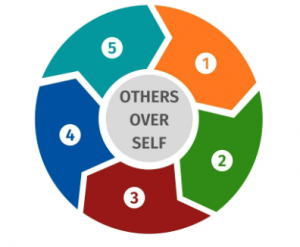IFI works directly with internationals, whether they’re staff or students. We deal with people from different cultures daily, sometimes facing tricky situations we’re unsure of how to handle. These could be related to language barriers, cultural barriers, or even spiritual barriers in regard to sharing our faith.
Before moving on to the topic of cultural humility, it’s important to explain what culture is so we have a good foundation!
CULTURE
Culture is the set of values, traditions, and beliefs of a particular social group. Culture isn’t just about race and ethnicity; culture is also related to the background and beliefs of a person.
Culture often manifests itself as an iceberg– the cultural practices we see constitute only 10% of culture, while the other 90% are factors we don’t see, such as values, assumptions, thoughts, etc.
Culture is often more complex than imagined! And soon you’ll find out why cultural humility is important!
So what is it?
CULTURAL HUMILITY
Cultural humility involves recognizing and respecting the cultural diversity and individual differences of others and having a willingness to learn about them.
Developing cultural humility is a challenge; to adopt cultural humility is to go against our pattern of thinking, which, due to human nature, may be one of judgment, bias, and criticism at worst, and at best, a distorted understanding of the truth.
Don’t believe me? Let me show you how our brains tend to work:
Example #1
If I ask, Where is she from? You’ll probably say Japan.
If I ask, What kind of food does she like? You’ll probably say sushi or some other Japanese food.
If I ask, What is her religion? You’ll probably say Buddhism.
Example #2
If I ask, Where is he from? You’ll probably say Brazil, as the flag is painted on his face.
If I ask, What is his favorite sport? You’ll probably say soccer.
And if I ask, What kind of musical style does he like? You’ll probably say samba.
Our brain likes patterns, so when you see a picture of a Japanese lady or a Brazilian guy, your brain naturally gathers information it already knows about Japan or Brazil and makes assumptions.
This pattern of thinking is pretty far from cultural humility because our brain is making snap judgments. Our challenge is to go against the automatic and practice self-awareness.
When we apply cultural humility to our lives, we remind ourselves of the limits of our knowledge and experiences, resisting the urge to lock ourselves into our own preconceived notions.
Cultural humility involves an ongoing process of self-exploration, combined with a willingness to learn from others.
But how exactly do you develop cultural humility?
CULTURAL HUMILITY WHEEL
For those who work with internationals, cultural humility should be ingrained in your lifestyle and not used simply as a tool to reach international students.
The Cultural Humility Wheel can help us nurture our cultural humility.
This wheel is a visual representation designed to assist individuals and professionals in developing cultural humility and enhancing their cultural competence. It’s a framework that guides individuals through various aspects of self-awareness, learning, and interaction with people from diverse backgrounds. The wheel typically consists of sections, each representing different dimensions or domains of cultural humility.
Let’s dive in…
Wheel Center – Others Over Self
Does this sound familiar? Putting others over self is actually a Biblical principle that existed way before it was a part of the cultural humility wheel! This principle is tied to one of the greatest commandments in the Bible– to love one’s neighbor just like Jesus, demonstrating selflessness and sacrificial love through His words and actions. The passage in Philippians 2:3-4 summarizes this concept well:
“Do nothing out of selfish ambition or vain conceit. Rather, in humility value others above yourselves, not looking to your own interests but each of you to the interests of the others.”
The core of cultural humility is to put relationships at the center of what we do. In this case, considering others before yourself. So let’s cultivate curiosity and empathy about peoples’ experiences and perspectives. Once they realize you’re interested in learning about their culture, a door to a relationship is opened, making connection easier.
1. Be Humble & Adaptable
It’s necessary to be humble and adaptable, recognizing that we are beginners in learning about cultures and perspectives different from our own. In this process, we can practice putting our assumptions aside and invest time in education about the other. Finally, be patient with yourself, as cultural humility is a lifelong learning process, and it’s OK to not know it all! Besides, you’re learning!
2. Become Self-Aware
It’s important to know what you’re thinking and/or feeling. This self-awareness helps you understand the thought patterns your brain is creating that lead you to make conclusions about people, as in the example of the Japanese lady and the Brazilian guy earlier. Remember: our values and behaviors are shaped by our knowledge and experiences; therefore, getting to know new cultures and perspectives broadens your knowledge and experiences, leading you to new patterns of thinking.
3. Understand We All Have Unique World Views
We’re multidimensional beings, meaning each one of us has different backgrounds, experiences, and beliefs– so let’s respect that! Part of the fun of making friends and being human is discussing these things with one another and coming to a more full understanding about why someone else sees things the way they do as well as sharing respectfully how we came to our own points of view.
4. Learn What’s Most Important to Others
Put on someone else’s shoes and understand what’s important to them. Here are some tips:
- Listen to what the other is saying without making judgments, dedicating quality time so they feel heard, seen, and known, thus feeling comfortable presenting their point of view
- Be genuinely interested in what the other is sharing, which involves curiosity and asking questions to understand their context and what’s shared
- Paraphrase, as it’s a valuable technique that involves expressing our own understanding of the information being presented in our own words. This enhances the richness and precision of communication among the individuals engaged in the process
- Accept silence, as this often means the person sharing a situation needs time to adjust the ideas in their mind before speaking (especially if it’s a foreign language they’re using to express themselves). In addition to being a sign of respect, silence often helps us process what’s happening
- Maintain eye contact, as it implies being 100% present in the conversation. Put your phone, email, TV, and any other distractions aside to effectively participate in the conversation
- Focus on the content presented and pay attention to your emotions. The combination of reason and emotion helps us understand what’s being shared, allowing us to contribute to the conversation
5. Advocate for Equity
Become an advocate and ally, doing so for social justice, equity, and inclusivity, both individually and collectively. It encourages individuals to work on behalf of marginalized and underrepresented groups.
Let’s work together as God’s people to create safe environments with honesty and transparency, where any type of person feels free to share their story.
🧡
That’s all for now, folks. Make sure to check out PART 2 of this post, where we give you practical tips to get your cultural humility game on!






